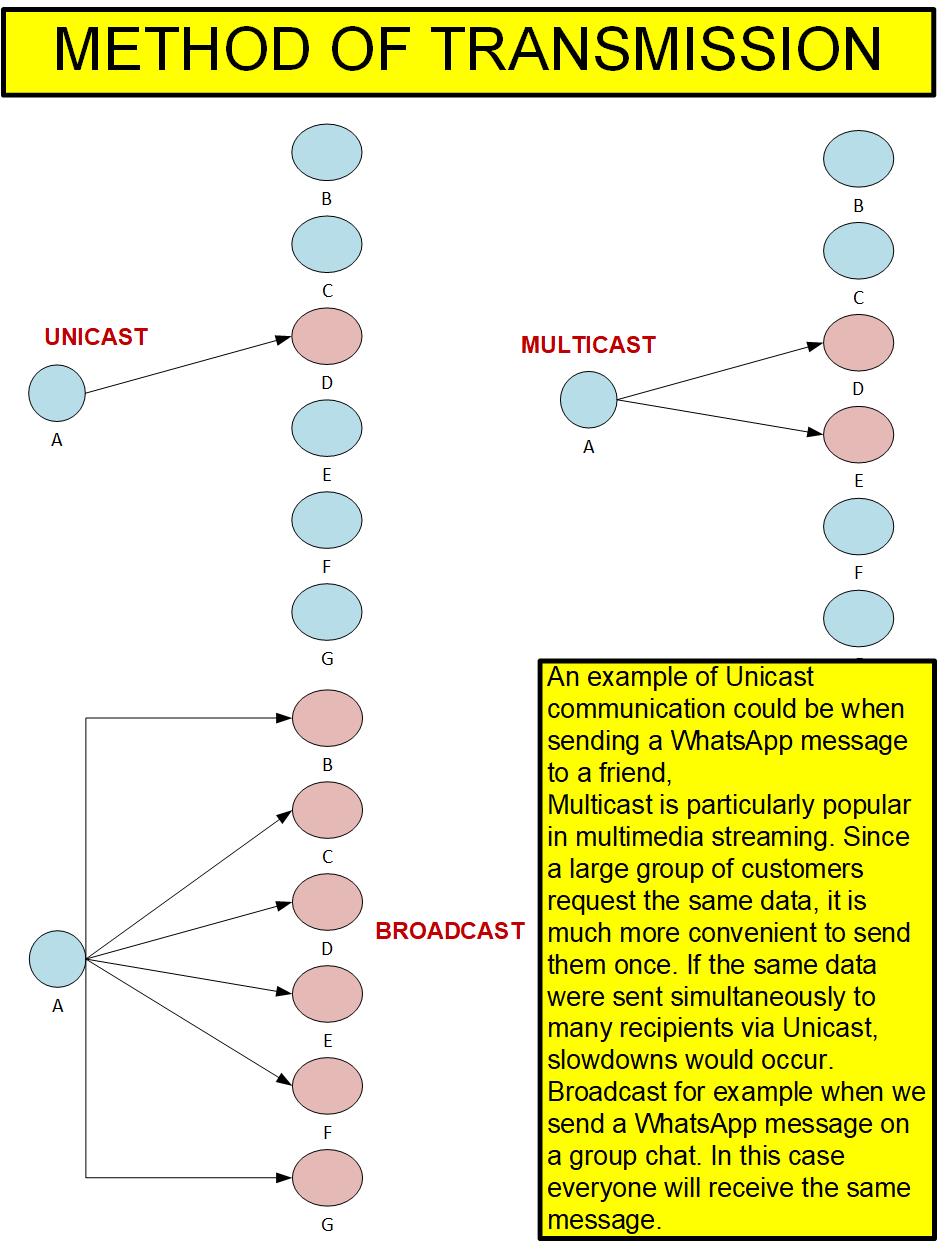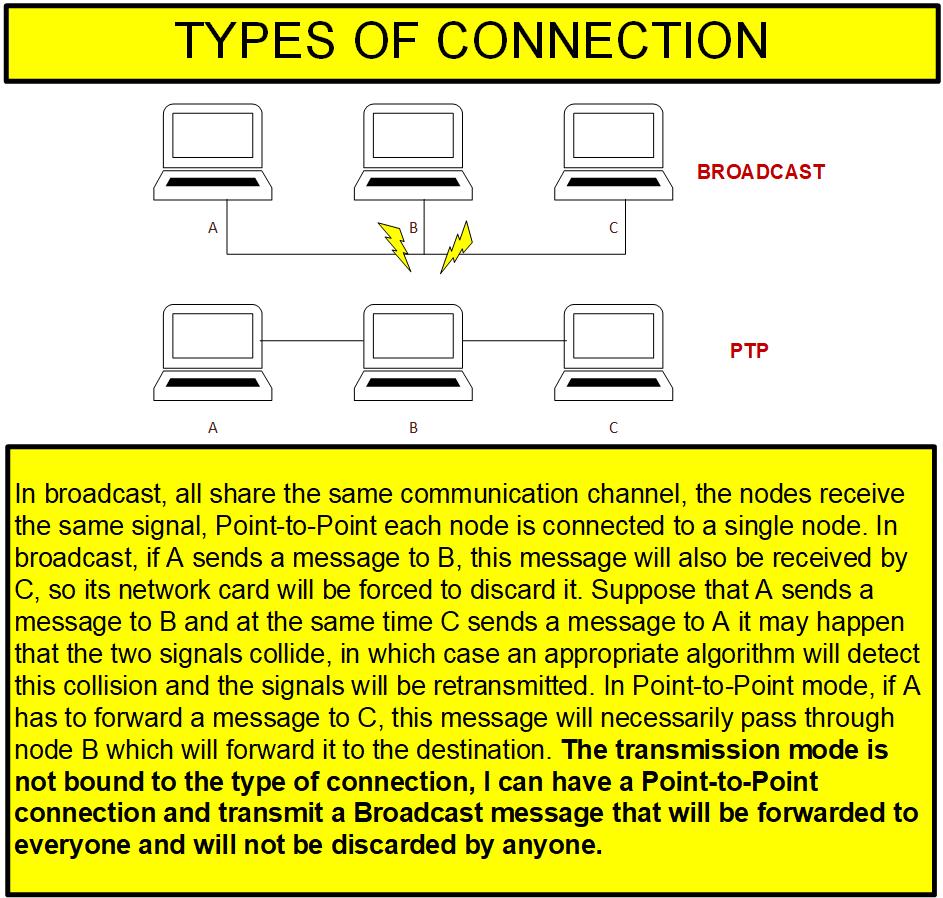METHOD OF TRANSMISSION
There are three ways:
- Unicast when there is a sender and a recipient;
- Multicast when sending a message from one sender to multiple recipients;
- Broadcast when a sender sends a message to all recipients for example in a WhatsApp group chat.
UNICAST


UNICAST VS MULTICAST
Two types of communication Unicast and Multicast have clear similarities, in particular with respect to Broadcast. The broadcast is sent to a dedicated address. All network participants recognize this and can respond to the data packet. Unicast and Multicast, on the other hand, are addressed to specific destinations; the other participants in the network do not take note of the data and do not respond.
Unicast and Multicast differ in that Unicast is sent to a single recipient and Multicast to an entire group of recipients. But Multicast is not intended as a collection of single Unicasts. Sending takes place via a Multicast address. This allows forwarding to all members of the Multicast group via a router or server. The group must already exist before the data transfer and cannot be defined by the source node at the time of sending.
The advantage of Multicast over multiple Unicast, ie the transfer to multiple Unicast addresses, consists in the single sending of the data packet. If multiple Unicasts are used, the packet is sent back over the network each time. Multicast sends the packet only once. The data is multiplied only in the list of recipients, with a consequent saving in terms of bandwidth. This is why multicasts are particularly popular in multimedia streaming. Since a large group of customers request the same data, it is much more convenient to send them once. If the same data were sent simultaneously to many recipients via Unicast, slowdowns would occur.

TYPES OF CONNECTION
There are two types of connection:
- Broadcast
- PTP (Point-to-Point)
BROADCAST NETWORK
- the same physical transmission channel is used, dividing the communication into packets
- each packet contains the identification of the recipient who receives and reads the data packet, the other nodes in the network discard it
- it is possible to send packets destined to all nodes of the network (Broadcast)
- it is possible to send packets destined to some nodes of the network (Multicast)The peculiarity of broadcast is that there is only one device that sends the signal and all the others receive the same information / data in the same way and at the same time. Another typical example is the television radio network consisting of the zone emitter antenna device and the television devices. This is a broadcast network as the signal emitted by the antenna (emitter) is received by all the antennas of the televisions of all the houses that are within the range of coverage of the signal.
POINT POINT NETWORK
- the transmission channel is reserved for communication between two network nodes
- to get a data item to its destination, the packet must pass through multiple nodes connected to each other in “point-to-point” mode: a routing algorithm is used to route the packet to the destination nodePoint-to-Point networks consist of a set of connections between pairs of computers, which form graphs of various types (star, ring, tree, complete graph, secant rings, etc.). To pass from a source to a destination, the information must pass through several intermediate processors. The path that the data must follow to arrive correctly at its destination is given by the Routing protocols. Routing is the set of problems relating to correct and effective routing on the data network.

NETWORK TOPOLOGIES
RING
CONFIGURATION
The ring network is a system where the nodes are arranged in the shape of a circle, creating a ring, therefore without the existence of terminal nodes. A circular cable connects the computers together. This topology is used for the WAN network, which often makes use of optical fiber, a unidirectional transmission medium.
HOW A RING NETWORK WORKS
Each node examines the packet it receives to decide whether it should acquire it or pass it in turn. Moving from one computer to another, the received data signal and transmission ends when the packet makes a full turn and returns to the transmitting node. The path can take place in:
- Unidirectional, clockwise or counterclockwise depending on the case, in which there is a high risk of failure because if one connection does not work, it compromises the entire network.
- Bidirectional, so each node can send the message to both the previous and the next node. In this mode, any failure can be easily remedied by taking advantage of the still practicable direction.
THE ADVANTAGES
- High extensibility of the network, guaranteed by the enhancement of the signal by each node;
Ease of implementation; - Simple system to build and fast enough.
THE DISADVANTAGES
- Low fault tolerance regarding the one-way ring because if there is a problem with a single cable or node, the entire network is blocked;
- Low diffusion: today this topology has almost disappeared in companies but was used in the first fiber optic systems (FDDI) that have now evolved. Token rings, a technology widespread in mid-range computers, are also abandoning the ring topology;
- Difficulty of expansion due precisely to the risk of failure, but less in bidirectional networks which are the most widespread among ring ones.
MESH
Mesh topology is also known as mesh topology, an Anglo-Saxon unit of measurement for measuring the number of meshes in certain materials. It is a network in which all the nodes are connected to each other and each of them can reach another through a single passage. In the event that one of the cables were to break, it would still be possible for the packets to arrive at their destination. A mesh with multiple paths between the nodes is therefore formed.
The knitted topology can in turn be:
- partially connected if only a part of all the direct connections existing between the nodes are used;
- fully connected if each node is directly connected with all nodes through dedicated branches.
HOW A MESH NET WORKS
In this case, a two-way communication takes place, i.e. both in terms of transmission and reception. For example, in a network consisting of 8 computers, each of them should have seven connections, for a total of 28 cables (7 + 6 + 5 + 4 + 3 + 2 + 1).
An application of this system are metropolitan and geographic networks.
THE ADVANTAGES
- Maximum speed;
- Maximum tolerance for any errors, because there is always an alternative route to get to a particular node, unless the latter remains completely isolated.
THE DISADVANTAGES
- Complex to build and difficult to expand due to the high number of connections;
- Rather high cost both for the construction and for the management of the different branches required
STAR
CONFIGURATION
In the star network topology there are many child nodes, all connected to a parent node which is located in the center of the star and which can be: a hub, i.e. a central hardware system which simply sends a duplicate of each package, indistinctly. In this case we speak of broadcast packets, an expression that can remember the WhatsApp broadcast list in which the same message can be sent to a predefined list of people. A network switch, that is, a device that ensures communication between the different nodes and knows the connections of the individual computers.
HOW A STAR NETWORK WORKS
The central node, whether it is a hub or a switch, manages the functions of the network: each child node, before entering into communication with another, must send the message to the central node that will sort it out. The most common application context is LAN networks. However, a standard star topology is only suitable for small networks that tend to expand, creating extended star topologies: the networks are constantly expanding, just like the universe according to most physicists and astronomers.
THE ADVANTAGES
- Great reliability since any failures do not compromise the operation of the entire network. Only the failed node remains isolated, while the others continue to function through the mediation of the central node;
- Easy expandability, i.e. multiple star networks can be connected to each other by connecting only the hubs as if they were two nodes of the same star. A concatenation, or cascade connection, is thus created, from which the so-called expanding star network originates.
- Network always available thanks to this type of connection, so each computer can send data at any time.
THE DISADVANTAGES
- Risk of overloading the parent node in cases of intense network traffic;
- Possible network block if the hub or switch stops working;
- Need for an additional component (hub) to intervene in case of problems.
TREE
CONFIGURATION
The tree network can be defined as a topology with a hierarchical and multilevel structure, because two others at a lower level are connected to each node.
HOW A TREE NETWORK WORKS
The parent node or root node (root) is connected to the child nodes here also called leaves (leaves) which can in turn be parents, creating a new hierarchical structure. Each node can be reached through only one path.
THE ADVANTAGES
- Low costs that guarantee an excellent relationship between price and speed and less complexity of implementation;
- Easy expandability through child nodes which can become roots themselves as seen above.
THE DISADVANTAGES
- There is no fault tolerance: since if a connection leading to a parent node is interrupted, all his descendants are also isolated;
- Total blocking risk if the main root node fails.
BUS
CONFIGURATION
In the bus network, all computers are connected to a single cable, a common transmission channel called backbone or bus. This system, which has characterized Ethernet networks for years, ensures that the data “traveling” on the bus is readable by all the nodes even if they are not the recipients.
HOW A BUS NETWORK WORKS
Each node “touches” the bus to examine the packets contained in it. If the node is the recipient of that packet, it acquires it otherwise it ignores it if it is destined for other computers. At each end of the backbone there is a terminator, a component that absorbs data not received from any computer, thus freeing the main cable which is ready to send new ones.
THE ADVANTAGES
- Low costs and simple to make;
- Easily expandable and combinable with star networks. A bus can connect the hubs or switches of the various stars, for example in buildings where two or more different teams work.
THE DISADVANTAGES
- Close dependence on the backbone, which, in case of failure, compromises the entire network;
- Low speed due to the fact that a single cable is used for data transmission, so that only one computer can send data at a time and, if there are many, data transmission times are lengthened.


Leave A Comment